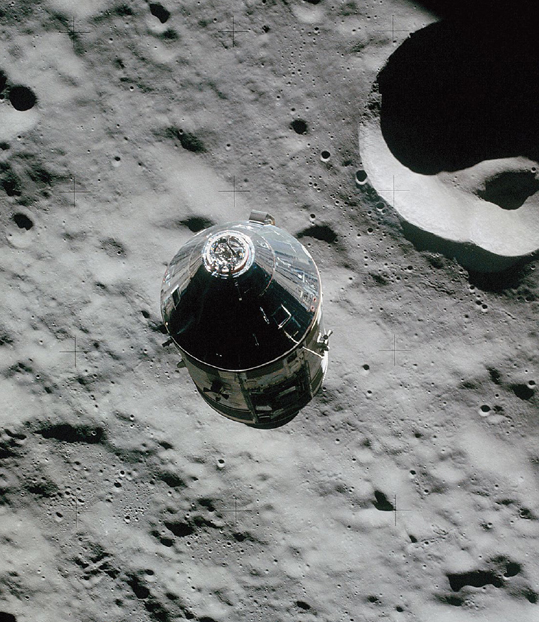1972
Lunar Highlands
John W. Young (b. 1930), Charles M. Duke, Jr. (b. 1935), T. Kenneth Mattingly II (b. 1936)
The four Apollo lunar-landing missions prior to 1972 had primarily targeted the Moon’s flat, dark, volcanic plains or gently rolling hills close to major volcanic regions. The decision to choose those areas as landing sites was based mostly on landing safety considerations. Lunar scientists knew that the dark mare (flat, volcanic) regions cover less than 20 percent of the Moon’s surface, however, and so more than 80 percent of the Moon’s more typical bright, mountainous geology—the highlands—was going unexplored. The goal of the Apollo 16 mission was to rectify that imbalance.
Astronauts John W. Young and Charles M. Duke, Jr., guided their lunar module Orion down into a rugged highlands region near the crater Descartes, in a smoother area containing a unit that geologists call the Cayley Plains. The hypothesis before landing was that the Cayley Plains, a relatively flat unit that fills in many craters and valleys among the highlands in many places across the Moon, might be a different kind of volcanic deposit that is unique to the lunar highlands. Because of its widespread nature, sampling this material was important to understanding the Moon overall.
Young and Duke spent more than 20 hours, over the course of four “extravehicular activity” excursions, walking on the Moon and driving their lunar rover more than 17 miles (27 kilometers) to collect a wide variety of highlands samples. After three days on the surface, they redocked Orion with the command module Casper and rejoined pilot T. Kenneth Mattingly II for the three-day return to Earth.
Surprisingly, the Apollo 16 samples did not show evidence for widespread highlands volcanism. Instead, the highlands are dominated by lower-iron, lower-density silicate minerals than the mare regions, a discovery that led to the idea that the Moon once had a molten “magma ocean” crust, enabling the heavier elements to differentiate or sink into the mantle and core. The Cayley Plains turned out to be a widespread deposit of ejecta—smashed-up, mostly highlands material redistributed over the landscape by the bombardment of the lunar surface by asteroids and comets over the eons.
SEE ALSO Birth of the Moon (c. 4.5 Billion BCE), First on the Moon (1969), Second on the Moon (1969), Fra Mauro Formation (1971), Roving on the Moon (1971).
The Apollo 16 command and service module Casper, piloted by Ken Mattingly and photographed in lunar orbit by astronauts John Young and Charlie Duke after they undocked the lunar module Orion and prepared to land on the Cayley Plains.
